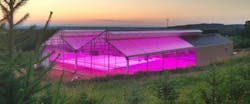In September, chief editor Maury Wright reported a horticultural solid-state lighting (SSL) project supplied by LumiGrow with grower South Mountain MicroFarmin an aquaponics application. To catch you up briefly, South Mountain has a 7500-ft2 greenhouse that features both a hydroponic leafy greens growing operation and tanks for raising tilapia that also circulate nutrient-rich water to the plant crops.
Based on a comment below that story, I posed the question: “Are LED grow lights for hydroponic applications different from those used in aquaponics?” Rather than exaggerate the proportion of my knowledge on the demands of hydroponic versus aquaponic operations and appropriate lighting selection, I turned to a source at LumiGrow — marketing director Brandon Newkirk.
Before we turn to Newkirk’s response, let’s define the terms here. I never want to assume we are all on the same page when it comes to adding vocabulary to the lighting and applications lexicon.
According to the University of Massachusetts – Amherst Extension Center for Agriculture, Food, and the Environment (CAFE) Greenhouse Crops & Floriculture program, “Hydroponics, in its most basic definition is a production method where the plants are grown in a nutrient solution rather than in soil.” And the US Department of Agriculture (USDA) National Agricultural Library defines aquaponics as “a combination of fish and plant production using aquaculture and hydroponics systems.”
Now on to the answer! Newkirk responded that “Aquaponics applications are similar to hydroponic applications, whereas the primary difference is how the water is being recirculated. Just like any horticultural application, crop type and facility will play an important role in the amount of light required and spectrum’s ability to control crop growth. Other than selecting a quality LED fixture, there are not specific aquaponics versus hydroponics requirements on the crop cultivation side of the operation.”
He continued, “That said, aquaponics operators use underwater lighting for fish tanks” and he indicated that since the primary function of the grow lighting is for crop production in such a combined installation, applying the appropriate spectrum to the cultivars would be the priority. You can read more about spectral power distribution, horticultural lighting metrics and product qualification, and tailoring horticultural SSL output in our linked articles.
Still, note a solid secondary point here. If you need to design or specify underwater lighting for an aquaponics operation, then it must meet appropriate requirements for that wet environment. Materials and seals and IP (Ingress Protection) ratings would be pretty important to the user.







